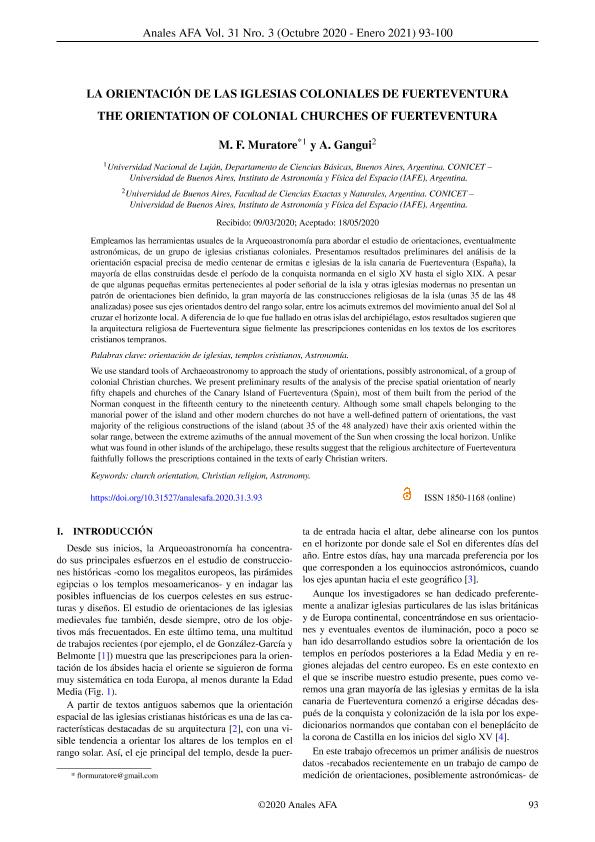Mostrar el registro sencillo del ítem
dc.contributor.author
Muratore, Maria Florencia

dc.contributor.author
Gangui, Alejandro

dc.date.available
2022-07-07T02:53:16Z
dc.date.issued
2020-10
dc.identifier.citation
Muratore, Maria Florencia; Gangui, Alejandro; The orientation of colonial churches of fuerteventura; Asociación Física Argentina; Anales de la Asociación Física Argentina; 31; 3; 10-2020; 93-100
dc.identifier.issn
0327-358X
dc.identifier.uri
http://hdl.handle.net/11336/161494
dc.description.abstract
We use standard tools of Archaeoastronomy to approach the study of orientations, possibly astronomical, of a group of colonial Christian churches. We present preliminary results of the analysis of the precise spatial orientation of nearly fifty chapels and churches of the Canary Island of Fuerteventura (Spain), most of them built from the period of the Norman conquest in the fifteenth century to the nineteenth century. Although some small chapels belonging to the manorial power of the island and other modern churches do not have a well-defined pattern of orientations, the vast majority of the religious constructions of the island (about 35 of the 48 analyzed) have their axis oriented within the solar range, between the extreme azimuths of the annual movement of the Sun when crossing the local horizon. Unlike what was found in other islands of the archipelago, these results suggest that the religious architecture of Fuerteventura faithfully follows the prescriptions contained in the texts of early Christian writers.
dc.description.abstract
Empleamos las herramientas usuales de la Arqueoastronomía para abordar el estudio de orientaciones, eventualmente astronómicas, de un grupo de iglesias cristianas coloniales. Presentamos resultados preliminares del análisis de la orientación espacial precisa de medio centenar de ermitas e iglesias de la isla canaria de Fuerteventura (España), la mayoría de ellas construidas desde el período de la conquista normanda en el siglo XV hasta el siglo XIX. A pesar de que algunas pequeñas ermitas pertenecientes al poder señorial de la isla y otras iglesias modernas no presentan un patrón de orientaciones bien definido, la gran mayoría de las construcciones religiosas de la isla (unas 35 de las 48 analizadas) posee sus ejes orientados dentro del rango solar, entre los acimuts extremos del movimiento anual del Sol al cruzar el horizonte local. A diferencia de lo que fue hallado en otras islas del archipiélago, estos resultados sugieren que la arquitectura religiosa de Fuerteventura sigue fielmente las prescripciones contenidas en los textos de los escritores cristianos tempranos.
dc.format
application/pdf
dc.language.iso
spa
dc.publisher
Asociación Física Argentina

dc.rights
info:eu-repo/semantics/openAccess
dc.rights.uri
https://creativecommons.org/licenses/by-nc-sa/2.5/ar/
dc.subject
ASTRONOMY
dc.subject
CHRISTIAN RELIGION
dc.subject
CHURCH ORIENTATION
dc.subject.classification
Astronomía

dc.subject.classification
Ciencias Físicas

dc.subject.classification
CIENCIAS NATURALES Y EXACTAS

dc.subject.classification
Filosofía, Historia y Filosofía de la Ciencia y la Tecnología

dc.subject.classification
Filosofía, Ética y Religión

dc.subject.classification
HUMANIDADES

dc.title
The orientation of colonial churches of fuerteventura
dc.title
La orientación de las iglesias coloniales de fuerteventura
dc.type
info:eu-repo/semantics/article
dc.type
info:ar-repo/semantics/artículo
dc.type
info:eu-repo/semantics/publishedVersion
dc.date.updated
2021-08-27T20:49:47Z
dc.identifier.eissn
1850-1168
dc.journal.volume
31
dc.journal.number
3
dc.journal.pagination
93-100
dc.journal.pais
Argentina

dc.journal.ciudad
Buenos Aires
dc.description.fil
Fil: Muratore, Maria Florencia. Consejo Nacional de Investigaciones Científicas y Técnicas. Oficina de Coordinación Administrativa Ciudad Universitaria. Instituto de Astronomía y Física del Espacio. - Universidad de Buenos Aires. Facultad de Ciencias Exactas y Naturales. Instituto de Astronomía y Física del Espacio; Argentina. Universidad Nacional de Luján. Departamento de Ciencias Básicas; Argentina
dc.description.fil
Fil: Gangui, Alejandro. Consejo Nacional de Investigaciones Científicas y Técnicas. Oficina de Coordinación Administrativa Ciudad Universitaria. Instituto de Astronomía y Física del Espacio. - Universidad de Buenos Aires. Facultad de Ciencias Exactas y Naturales. Instituto de Astronomía y Física del Espacio; Argentina
dc.journal.title
Anales de la Asociación Física Argentina
dc.relation.alternativeid
info:eu-repo/semantics/altIdentifier/doi/http://dx.doi.org/10.31527/analesafa.2020.31.3.93
dc.relation.alternativeid
info:eu-repo/semantics/altIdentifier/url/https://anales.fisica.org.ar/journal/index.php/analesafa/article/view/2282
Archivos asociados
